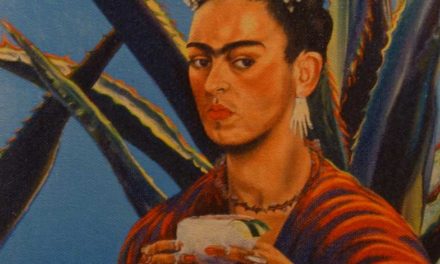By Dr. Ricardo Romo
It is fitting that the Texas A&M Kingsville Department of Art, Communication and Theater recently exhibited Marta Sanchez’ colorful renditions of trains and rail yards, a reflection inspired by her San Antonio neighborhood and familial memories. Sanchez is a highly accomplished Latina artist whose art was partly shaped and highly stimulated by the pioneering works of earlier graduates of the Kingsville campus: Carmen Lomas Garza, Santa Barraza, Amado Pena, and Cesar Martinez. These artists received their training on the Kingsville campus in the late 1960s and early 1970s. These artists have emerged as among the most celebrated Latino artists in America.
Born and raised in San Antonio, Sanchez attended Fox Tech High School and earned a Fine Arts degree from The University of Texas at Austin in 1982. Sanchez’ years at Austin were key to her development as a Chicana artist. On the UT campus Sanchez met Santa Barraza, a talented young artist and graduate student in the
University’s Master’s in Fine Arts program. Through Barraza she met Carmen Lomas Garza, Cesar Martinez, and Amado Pena—central figures in the development of Chicano art in Texas.
To find her own voice as an artist, Sanchez gained inspiration from Austin’s many exhibitions, plays, and jazz sessions. The Texas capital city also saw the emergence of local artists Raul Valdez, Luis Guerra, and Jesus Trevino during the 1980s. Sanchez wrote: “My work slowly turned from being purely artistic to becoming art that served a purpose as I evolved from being a student, to an artist, to a Chicana artist.”
Marta Sanchez’ art gained national prominence with her inclusion in the Cheech Marin Chicano Visions exhibition in 2000. While the exhibition travelled to numerous cities across America, her reputation was further enhanced with the inclusion of her works in Marin’s book, Chicano Visions: American Painters on the Verge.
The 2020 Kingsville exhibition focused on Sanchez’ paintings and prints inspired by the trains and rail yards of her hometown of San Antonio. For much of her life Sanchez has been fascinated with railroads. Her family lived a few blocks from the large rail yards of San Antonio
and from her porch she often watched trains come and go. As a child she also admired the train track patterns and the many hundreds of trains that arrived there on a daily basis. As a young artist she visited the railroad yards often and “would draw the landscape full of trains and wonder about their departures and arrivals.”
Growing up, Marta Sanchez’ neighborhood was bordered by Fort Sam Houston Army base and the eastern railroad yards of the city. Both the military base and the train yards were historically connected. The Indian Wars of the 1870s and 1880s brought military personnel and supplies to San Antonio fulfilling a desire by Army generals to establish a major presence in the Alamo City. In anticipation of the new railroad line, Army engineers began construction of the famed Fort Sam Houston base in 1876, a year before the completion of the planned depot. When the legendary Apache Indian Chief Gernomino was captured by the Fifth Army Infantry Division in 1886, he was transported with thirty of his men on a special train from Bowie, Arizona to Fort Sam Houston.
Beginning in the late 1880s trains brought manufactured goods to the city and made possible the shipment of raw resources, such as cattle and agricultural
products. Moreover, Mexican workers helped build the railroad lines and used them as a means of moving to and from San Antonio. The railroads also brought the Carpas–Mexican Circus– to San Antonio and South Texas. In her art, Sanchez captures that imagery of Mexican circus performers unloading their giant tents and trained animals gathered and ready for action.
Over the next seven decades San Antonio’s central location in the state made it a major hub of railroad activity. When thousands of Army Air Corp trainees left for military duty in the Pacific during World War II, they boarded a train at the Sunset Station near the rail yards which took them to San Francisco. At the time, 97 percent of all organized troop movements utilized trains for transportation. In addition, 90 percent of all military equipment went by rail during the war years. In recent years, the railroads have been central to the transportation of sand and gravel for the Eagle Ford oil patches in South Texas as well as a major transport means for newly manufactured vehicles assembled at the Toyota plant south of San Antonio downtown.
The railroads came to San Antonio 120 years before any artist took an interest in them. Sanchez wanted to
change that. She considered the railroad key to San Antonio’s early economic development. Sanchez captures many aspects of the rail yards: the physical tracks, the men and women workers, the arrival of the Mexican circus, as well as memories of her father on the porch which offered a view of the coming and goings of trains. Sanchez’ work is a powerful artistic observation of a world she witnessed growing up as well as a deep introspection of her memory and the social order surrounding her early life.









